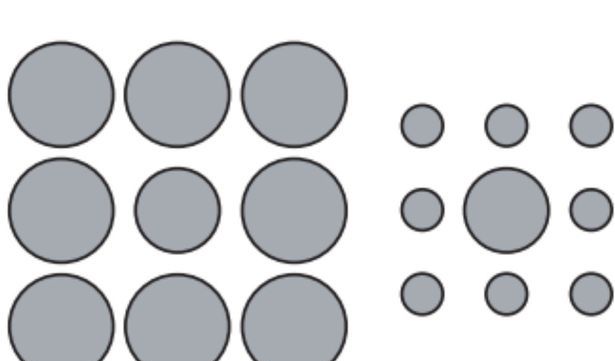骗的了大人却骗不过小孩的视觉错觉!
 Which is the bigger circle? 所以,哪个圆更大? You may have encountered the Ebbinghaus illusion before when learning about relative size perception. Named after the man who discovered it, German psychologist Hermann Ebbinghaus, the illusion itself became very popular at the start of the last century. 在你了解视觉大小知觉的概念时,你也许要先接触下艾宾斯浩错觉。 艾宾斯浩错觉以其发现者德国心理学家赫尔曼艾宾斯浩命名。在上世纪初,这个理论风靡一时。 But why aren't children tricked by it? 为什么儿童不容易出现视觉错误? A recent study done by Martin Doherty, from the University of Stirling's Department of Psychology revealed the results. 来自斯特灵大学心理系的马丁多尔蒂最近的研究显示出儿童被艾宾斯浩错觉误导的几率要小的多。 The experiment use one hundred and fifty-one children between the ages of four and ten, and 24 adults between the ages of 18 and 25. 实验对象是151位4-10岁的儿童以及24位18-25岁的成人。 They were shown images very similar to the ones above, with a two to 18 per cent size difference. 他们看到的图形与上面提到的相同,但是大小相差2%-18%。 When asked if they were the same size, the children demonstrated an ability to discern the sizes of the circles, in spite of the confusing 'context' (i.e. being surrounded by other circles of different sizes). 而关于这些圆的大小的问题,尽管存在错觉背景(即被大小不同的圆环绕),儿童却能辨认圆圈的大小。 Adults were tricked by misleading context, but children under the age of seven nearly always correctly identified the size of the orange circle . 而成年人却总是被误导信息欺骗,但是7岁以下的儿童却总是能正确地识别出圆的大小。 It is thought this is because adults' brains take into account the visual context - so, in the instance of the Ebbinghaus illusion, shapes surrounding other shapes. But in children, it takes time for them to develop this ability which ultimately makes them better at this illusion than us, as they the shapes and their sizes for what they are. 这样的现象被归因于成年人的大脑考虑了视觉背景,即在艾宾斯浩错觉中被诱导圆包围的测验圆。 而艾宾斯浩错觉中的大小对比不是人脑与生俱来的属性,而是在后期发展中形成的。因此,当背景提供误导信息时,儿童比成人更准确地判断圆圈的大小。 |








